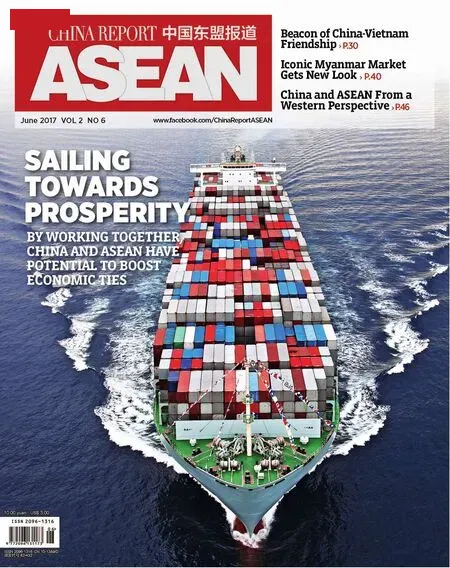AIIB A DRIVING FORCE BEHIND ASEAN DEVELOPMENT
By Wang Jiping
AIIB A DRIVING FORCE BEHIND ASEAN DEVELOPMENT
By Wang Jiping
Bank Vice President Joachim von Amsberg sees a bright future ahead for regional infrastructure projects
Since its initial establishment on Dec. 25, 2015, the Asian Infrastructure Investment Bank (AIIB) has now been operating for nearly one-and-a-half years. From the perspective of the business community, AIIB’s establishment has not only played an important role in Asia’s development, but has also facilitated the implementation of the Belt and Road Initiative on a global scale, as well as enhanced confidence in its success.
What then has AIIB accomplished over the past year? How has the bank contributed to the Belt and Road? What are its plans for the future? With these questions in mind, China Report ASEAN reporters visited the AIIB headquarters on Financial Street in Beijing’s Xicheng District, sitting down for an exclusive interview with the bank’s vice president Joachim von Amsberg.

Joachim von Amsberg, the Vice President (Policy and Strategy) of AIIB.
>> China Report ASEAN: It has been more than a year since AIIB was founded. How do you evaluate its operation and influence?
Amsberg:I think it is a little premature to talk about AIIB’s influence at this point, since it remains a “newborn” bank. But one thing is certain: we have made a good start. Our Board of Governors has so far approved nine projects in seven countries, with a total investment of US$1.7 billion, which cover all of our main interest areas including infrastructure.
We have attached importance to cooperation with other institutions, such as the World Bank, the European Bank for Reconstruction and Development (EBRD) and the Asian Development Bank (ADB). We have kept in mind that AIIB is a multilateral financial institution founded to bring countries together to address the daunting demand for infrastructure construction across Asia. Our priority is advancement in infrastructure, featuring a new type of multilateral cooperation. That is also a distinctive feature of governance in the new century, which will add to globaleconomic governance and adapt to the development of a multipolar world.
>> China Report ASEAN: How do you view the relationship between AIIB’s development and the Belt and Road?
Amsberg:First, I think AIIB’s institutional goals coincide with the direction of Belt and Road construction in some ways, and vary in others. For one thing, the development of the Belt and Road embraces the trend toward a multi-polar world, economic globalization and greater IT application. It has been designed to uphold the global free trade regime and the open world economy in the spirit of open regional cooperation. This has been a development philosophy respected by our bank. What’s more, infrastructure connectivity is not only the priority area of the Belt and Road Initiative, but also a focal point for AIIB.
What is noteworthy is that AIIB cares about investment in not only the countries along the Belt and Road, but also those that are not on the route. Of course, some of the 57 founding members are along the Belt and Road. If they do have some suitable investment projects, we will definitely provide them with priority support.
Secondly, I think the Belt and Road will bring AIIB further investment opportunities. In other words, to a certain extent, AIIB will be a multilateral development institution contributing to interconnectivity and the building of the Belt and Road, which means that AIIB will go further and further on the Belt and Road to provide strong financial support for the development of relevant countries and the stability of different regions.
>> China Report ASEAN: We have noticed that AIIB’s major concerns include rural infrastructure and agricultural development, power and energy applications and environmental protection. What are the efforts that AIIB has made over the last year in promoting development in those areas?
Amsberg:To promote development in these areas, we have persisted in the development of sustainable infrastructure construction. We have paid attention to transboundary connectivity in order to boost the vitality of private capital. Therefore, we have allocated investment reasonably in different areas based on our assessments of the situation on the ground.
For example, we are now working on a draft strategy on energy development and cooperation. The strategic framework, provisions and methods of implementation in this document will be a guide for AIIB action in the area of energy.
Additionally, we have been pushing a strategy for sustainable urban development lately. It is expected that the implementation of this strategy will provide more energy support for urban development, improve the efficiency of urban transport, reduce the emission of pollutants and increase urban residents’income in creative ways.
>> China Report ASEAN: ASEAN countries are an important part of the Belt and Road construction. In your view, what are the challenges for ASEAN countries at this stage? Within the framework of the Belt and Road vision, what will AIIB be able to do for them?
Amsberg:I think inadequate infrastructure remains the bottleneck of development in most ASEAN countries. Within the framework of the Belt and Road vision, I believe AIIB can provide ASEAN countries with assistance in this regard. Of course, we would very much hope that our efforts will win the cooperation and support of governments and relevant institutions in those countries.
For example, in June 2016, AIIB decided to provide Indonesia with a loan of US$216.5 million to rebuild its run-down areas. The implementation period of the project is from September 2016 to June 2021. The Ministry of Public Works and Housing of Indonesia is the executing agency of the project. We expect that 9.7 million people in 154 Indonesian towns will benefit from the project. Their living conditions will be greatly improved, with access to infrastructure similar to that in big cities.
Also, AIIB has taken into consideration a US$20 million loan to Myanmar for the construction of a natural gas power station in Mandalay, which would help to alleviate electricity shortages in some areas of Myanmar.
- China Report Asean的其它文章
- FREIGHT TRAIN ROUTE LINKS VIETNAM, SOUTHWEST CHINA
- The CPC Grows Together with the Chinese People
- South and Southeast Asia Commodity Expo and Investment Fair Held
- COOPERATION WITH SINGAPORE GROWS
- Xi's Kazakhstan Trip Cements Broader Cooperation
- THAI PM SET TO SPEED UP THAILAND-CHINA RAILWAY PROJECT

